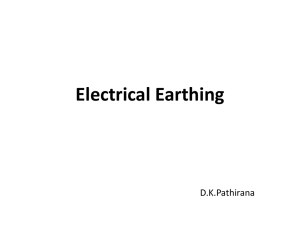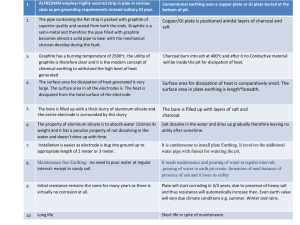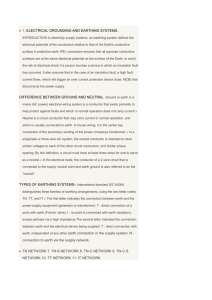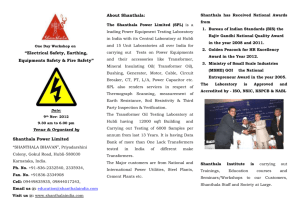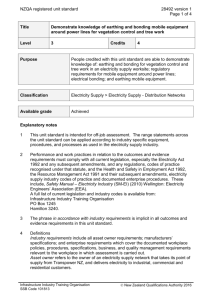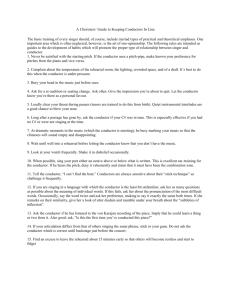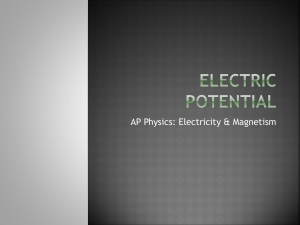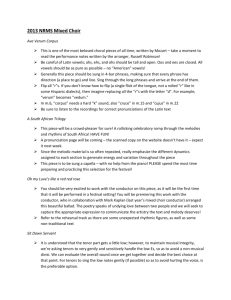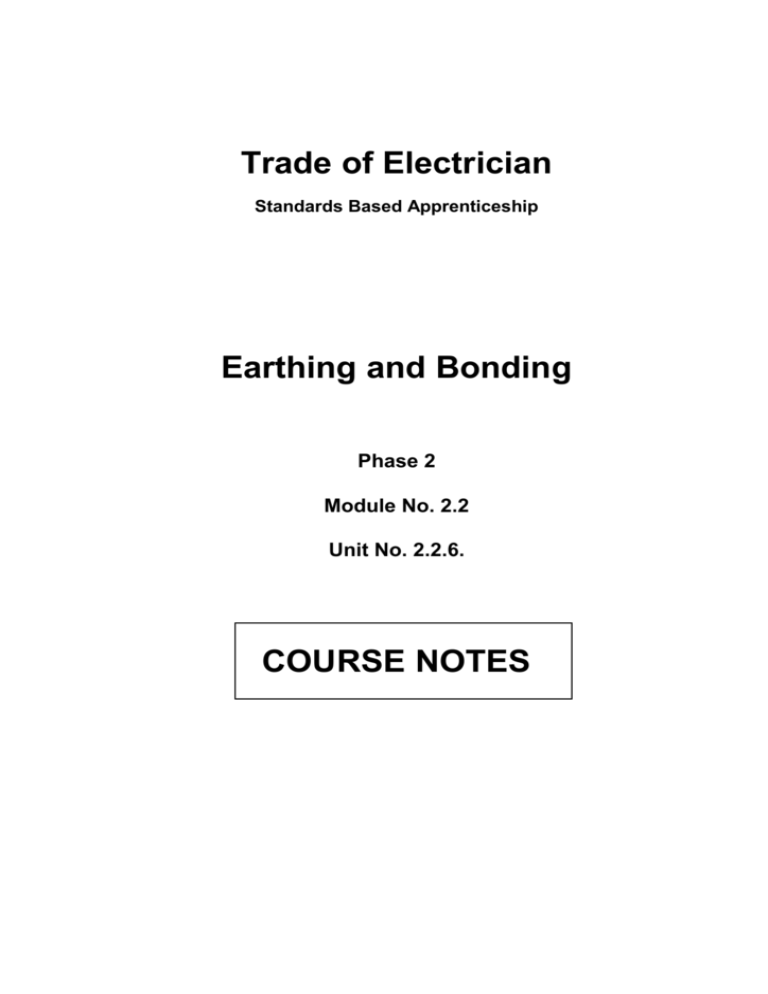
Trade of Electrician
Standards Based Apprenticeship
Earthing and Bonding
Phase 2
Module No. 2.2
Unit No. 2.2.6.
COURSE NOTES
Created by Eugene Trindles – Cork TC
Revision 1 April 2000 by
Eugene Trindles – Cork TC
Charlie Walsh - Athlone TC
Revision 2 Nov. 2002 by
Eugene Trindles – Cork TC
Chris Ludlow – Dundalk TC
Revision 3 May 2006 by
Chris Ludlow – Dundalk TC
Revision 4. Feb 2008 By
Chris Ludlow - Dundalk TC
Revision 5. July 2009 By
Chris Ludlow - Dundalk TC
Revision 6. October 2009 By
Chris Ludlow - Dundalk TC
Revision 5, November 2013
SOLAS
Compiled by Liam Carroll – Certification & Standards
Published by
27-33 Upper Baggot Street
Dublin 4
Ireland
© SOLAS - 2013
All rights reserved. No part of this publication may be reproduced, stored in a retrieval system or
transmitted in any form or by any means, electronic, mechanical, photocopying, recording or
otherwise, without the prior permission of the copyright owner.
SOLAS
Electrical Course Notes - Unit 2.2.6
Table of Contents
INTRODUCTION..........................................................................................................................................4
DEFINITIONS ...............................................................................................................................................5
EARTHING....................................................................................................................................................6
TYPES OF SYSTEM EARTHING ............................................................................................................11
EQUIPOTENTIAL BONDING ..................................................................................................................14
UNIT RELATED ETCI RULES ................................................................................................................20
3
Revision 5, November 2013
SOLAS
Electrical Course Notes - Unit 2.2.6
Introduction
Welcome to this section of your course, which is designed to enable you the learner, understand
the terms earthing and bonding. It is vitally important to be able to distinguish between them.
There is a lot of confusion in this area on the part of a large number of people working with
electricity.
Objectives
By the end of this unit you will be able to:
Understand the term “earthing” and the reasons for earthing
Explain important terms associated with earthing
Install an earthing system in a domestic installation
Understand the term “bonding” and the basic reasons for bonding
Explain important terms associated with bonding
Install a main bonding system in a domestic installation
Install a local bonding system in a domestic installation
Reasons
Understanding this information will allow you install correctly the safety aspects of the
installation.
4
Revision 5, November 2013
SOLAS
Electrical Course Notes - Unit 2.2.6
Definitions
Normal Supply: An electricity supply taken from the supply authority ( DSO ) or alternatively
from the proprietor’s own generating plant
Earthing: The connection of the exposed conductive parts of an installation to the main
earthing terminal or bar.
Main Earthing Terminal ( MET ) or Bar: A terminal or bar provided for the connection of
protective conductors, main equipotential bonding conductors and conductors for functional
earthing if any, to the means of earthing.
Main Protective Conductor: A conductor that connects the main earthing terminal or bar to
the supply neutral.
Earthing Conductor: A conductor connecting the main earthing terminal or bar to the earth
electrode.
Earth Electrode: A conductive part or a group of conductive parts in intimate contact with, and
providing an electrical connection with, earth.
PEN Conductor: An earthed conductor combining the functions of both protective conductor
and neutral conductor.
Note: The acronym PEN comes from the combination of the symbols PE for the protective
conductor and N for the neutral conductor.
Bonding: See Equipotential Bonding.
Equipotential Bonding: Electrical connections intended to maintain exposed conductive parts
and extraneous conductive parts at the same or approximately the same potential, but not
intended to carry current in normal service.
Equipotential Bonding Conductor: A protective conductor for ensuring equipotential
bonding.
5
Revision 5, November 2013
SOLAS
Electrical Course Notes - Unit 2.2.6
Earthing
Earthing is defined as “The connection of the exposed conductive parts of an installation to the
main earthing terminal”.
Main Earthing Terminal
Every installation must have a main earthing terminal. In domestic installations it is usually a
brass bar located at the top, bottom or side of the distribution board. It should have a suitable
range of terminals for all the conductors required to be terminated.
The following conductors may be connected to the main earthing terminal:
1.
2.
3.
4.
5.
The Main Protective Conductor in TN systems
Earthing Conductor
Functional Earthing Conductors ( communication systems )
Main Equipotential Bonding Conductors
Protective Conductors
The main earthing terminal must be easily accessed. This is primarily to allow disconnection of
any of the above conductors as required when testing the installation.
Main Protective Conductor
The main protective conductor connects the DSO neutral to the consumer’s earth electrode via
the main earthing terminal. It is commonly called the Neutralising Conductor. It must be
insulated and have the same cross-sectional area as that of the earthing conductor if both are
manufactured from the same material. If made from different materials they must have an
equivalent current carrying capacity.
Earthing Conductor
The earthing conductor must have green / yellow insulation over a copper conductor. It connects
the earth electrode to the main earthing terminal. The cross-sectional area of this conductor ( SE
mm2 ) is dependent on the cross-sectional area of the largest phase conductor in the installation
( S mm2 ), in accordance with the ETCI Rules.
S
SE
=
=
The cross-sectional area of the largest phase conductor.
The cross-sectional area of the earthing conductor.
Where the cable is exposed it should be protected by either steel or heavy duty PVC conduit or
piping.
6
Revision 5, November 2013
SOLAS
Electrical Course Notes - Unit 2.2.6
Protective Conductor
All circuits unless specifically designed for a non-conducting location will have a protective
conductor ( PE ) included. They must be capable of carrying the maximum possible earth fault
current to the DSO neutral, via the main earthing terminal.
They only have to carry this fault current for the time required to operate the circuit protective
device. In general, this time will not exceed five seconds. In the event of a fault, they prevent
exposed conductive parts becoming live with respect to earth.
The protective conductor may be a:
Separate conductor
Cable core
Cable armour
Metallic conduit
Metallic trunking
See Figure 1.
Figure 1.
7
Revision 5, November 2013
SOLAS
Electrical Course Notes - Unit 2.2.6
Earth Electrode
1200mm
The earth electrode can be any of the following types
Earth rods or pipes
Earth tapes or wires
Earth plates
Metallic reinforcement of concrete foundations buried in the ground may also serve as
an earth electrode.
See Figures 2 and 3.
Galvanised
Earth ( Rod )
Electrode
Earth Plate
Earth Tape Lattice
16mm
Figure 2
Figure 3
The galvanised earth electrode above is generally sufficient for a domestic installation.
The ETCI Rules cover more specific requirements for types of earth electrode.
8
Revision 5, November 2013
SOLAS
Electrical Course Notes - Unit 2.2.6
Function of the Earth Electrode
The function of the earth electrode is to maintain a connection between the general mass of
earth and metallic parts of the consumer’s installation. These can then be regarded as being at
zero potential. The earth electrode must be continuously effective and capable of carrying earth
leakage and earth fault currents, which may arise.
The effectiveness of an earth electrode in conducting fault currents will depend on its contact
with earth. Its contact with earth will vary depending on the type of soil in the area. The soil
may be heavy sticky soil, sandy soil, soil containing a large peat content, gravel or rocky soil
etc. Heavy sticky soil allows a low resistance connection to earth. Rocky soil results in
difficulty in making a good connection to earth.
Location and Installation of the Earth Electrode
In a domestic installation the earth electrode is normally located external to the building. It is
usually installed close to the meter cabinet. It is driven vertically into the ground and a
connection made to the protruding end. When driving the electrode, care should be taken to
avoid damaging it. Ensure that the electrode does not become fouled on any foundation work or
underground services.
In some cases it may not be possible to drive the electrode down to its full length e.g. if rock is
encountered. In such a case an alternative method must be used. The electrode may be buried
horizontally or one of the other recommended earth electrode types may be used. It is not
permitted to reduce the physical size of the electrode by cutting it. This will reduce its contact
area and impede its effectiveness.
The earthing conductor is connected to the earth electrode by a clamp supplied with the
electrode solely for this purpose. The connection must be mechanically and electrically sound,
keeping in mind that in the event of an earth fault the connection would have to carry a
substantial fault current. The connection is then sealed with a protective tape. This tape must be
capable of withstanding deterioration from weather and chemical influences. It must also resist
any attack by rodents and termites.
The earth connection must be in an enclosure with a removable inspection cover. The cover
must be labelled “SAFETY ELECTRICAL CONNECTION DO NOT REMOVE”
In public places this connection may be buried or hidden but in such instances it must be
available for inspection at the first energisation of the installation.
9
Revision 5, November 2013
SOLAS
Electrical Course Notes - Unit 2.2.6
Waterproof Tape
Denso tape is generally used to protect the termination at the earth electrode. Although it is
easily applied, it leaves a sticky residue on everything it comes into contact with. It has stood
the test of time. Terminations have been found to be in excellent condition after exposure to
arduous conditions for many years. It provides protection against the ingress of water and
against damage by chemical action, rodents and termites.
Figure 4
Another form of protection, which may be used is a self-amalgamating tape. This tape relies
on an internal chemical action between its layers. The action of stretching the tape around a
connection activates a chemical process. After a period of about thirty minutes the tape will
have formed into a solid rubber mass around the connection.
Earth Electrode Connection
Figure 5 shows a suitable type enclosure for housing the earth electrode connection.
Figure 6 shows the earthing conductor connected to the earth electrode.
Figure 7 shows the connection protected by Denso tape.
Figure 5
Figure 6
10
Figure 7
Revision 5, November 2013
SOLAS
Electrical Course Notes - Unit 2.2.6
Types of System Earthing
There are three types of system earthing used today.
These are: TN System
TT System
IT System
The TN system is the type used in this country. It is commonly referred to as a “neutralised
system”. This basically means that the supply neutral is connected to earth at the supply point.
There are three variations of this system; the one we use in Ireland is the TN-C-S system. The
two other variations are the TN-C system and the TN-S system.
Although all three are TN Systems the difference between them is in the way that the neutral
and protective conductors are arranged.
In the TN-C-S System the neutral and protective conductor functions are combined in a
single conductor in part of the system.
T = Direct connection of one point to earth.
N = Direct electrical connection of the exposed conductive parts to the earthed
conductor of the supply system. In AC systems the earthed
conductor is normally the neutral conductor.
C = Neutral and protective functions combined in a single conductor
( known as PEN conductor )
S = Neutral and protective functions provided by separate conductors.
11
Revision 5, November 2013
SOLAS
Electrical Course Notes - Unit 2.2.6
TN-C-S System
The 230 Volt single phase supply to a premises is taken from the secondary winding of a DSO
transformer. One terminal of this secondary winding is connected to earth ( ground ). This
terminal becomes the neutral for the system. The neutral conductor is therefore at earth potential
( zero volts ).
A two core concentric cable is generally used to connect from the supply network to the
premises. The centre core is the phase conductor. The outer core performs the functions of
neutral and protective conductors. This conductor is known as a PEN conductor. It is terminated
at the DSO main fuse unit.
PEN = PE for protective conductor ( protective earth ), N for neutral conductor.
From this point on, the neutral and protective conductors are separated and must not be
connected together, anywhere throughout the entire installation. The protective conductor is
referred as the Main Protective Conductor. It is connected to the Main Earthing Terminal of the
installation. This means that the Main Earthing Terminal is solidly connected to the DSO
neutral.
At each installation an earth electrode is provided. The earth electrode is connected to the Main
Earthing Terminal and therefore to the DSO neutral. This arrangement provides the consumer
with an earth terminal, which is connected to the neutral conductor of the system, thereby
providing a low impedance ( low resistance ) path for the return of earth fault currents.
Impedance is the ratio of AC voltage and current. The Ohm is the unit of impedance.
Its symbol is the letter Z.
12
Revision 5, November 2013
SOLAS
Electrical Course Notes - Unit 2.2.6
TN-C-S System Earthing
Figure 8.
13
Revision 5, November 2013
SOLAS
Electrical Course Notes - Unit 2.2.6
Equipotential Bonding
Bonding and earthing are two different operations. They must not be confused.
Bonding simply means making an electrical connection between all metal enclosures etc., of the
installation ( “exposed conductive parts” ) and the metal of all non-electrical services
( “extraneous conductive parts” ). This is done to ensure that no potential difference can appear
between any of these items under fault conditions. A potential difference appearing between any
two simultaneously accessible parts introduces the risk of shock to persons or animals in the
area.
There are two types of equipotential bonding:
1. Main Equipotential Bonding
2. Supplementary Equipotential Bonding
Main Equipotential Bonding
Main equipotential bonding connects together all conductive parts of the main engineering
services in an installation, to the main earthing terminal. Examples of the main engineering
services are:
Metal pipes for central heating, gas, water
Metal ducting for heating and air conditioning systems
Structural metal parts of the building
14
Revision 5, November 2013
SOLAS
Electrical Course Notes - Unit 2.2.6
Main Equipotential Bonding on a Domestic System
with Metallic Incoming Services
Distribution board
Main Earthing Terminal
Water Tank
2
Earthing
Conductor
10 mm
Air Conditioning
Ducting
500 mm
Max
Gas
Meter
Electrical
Insulating
Joint
Main Gas Supply
Pipe (Metallic)
Main Central
Heating Pipe
Main Water Supply
Metallic Pipe
Figure 9.
15
Revision 5, November 2013
SOLAS
Electrical Course Notes - Unit 2.2.6
Main Equipotential Bonding on a Domestic System
with Non-Metallic Incoming Services
Distribution Board
Main Earthing Terminal
Earthing
Conductor
Water Tank
10 mm2
Metallic
Pipe
Main Gas Supply
Pipe (Non-Metallic)
Main Central Heating
Pipe (Metallic)
Main Incoming Water
Supply (Non-Metallic)
Figure 10.
16
Revision 5, November 2013
SOLAS
Electrical Course Notes - Unit 2.2.6
Supplementary Equipotential Bonding
Supplementary equipotential bonding is generally applied to a location in an installation. It
connects together all extraneous conductive parts and all exposed conductive parts in the
location.
Water may conduct electricity. Extra safety measures should be applied to locations where
electrical equipment is used in close proximity to water or steam. Kitchens, utility rooms,
bathrooms and shower rooms are such locations.
Equipotential Bonding in a Kitchen / Utility Room
In kitchens and utility rooms, all extraneous conductive parts such as metal sinks and metal
pipes must be bonded together. This equipotential bond must then be connected to a local
protective conductor.
Kitchen Equipotential Bonding System
Metallic
Sink
Where pipe is metallic
Main Incoming
Water Supply
Domestic Hot Water
Figure 11
Note:
Even if both pipes are plastic the sink must be bonded.
17
Revision 5, November 2013
SOLAS
Electrical Course Notes - Unit 2.2.6
Equipotential Bonding in a Shower or Bathroom
Showers and baths provide an increased risk of shock hazard due to the reduction of body
resistance ( skin wet ) and the possibility of contact with earth potential. Extraneous conductive
parts and exposed conductive parts in an area containing a shower or bath are treated as being
within zoned areas.
Bathroom Equipotential Bonding System
Electric Towel Rail
Electric Panel Heater
2.5 mm2
Bonding
Conductors
Bonding to
Metallic Bath
Cold
Hot
Figure 12.
18
Revision 5, November 2013
SOLAS
Electrical Course Notes - Unit 2.2.6
Bonding Clip
The type of bonding clip used is corrosion resistant and adjustable to fit several sizes of pipe. A
locking device is provided to ensure that the clip cannot work loose through expansion /
contraction caused by heating / cooling or by vibration. The pipe should be first cleaned to
remove any residue from building materials or oxidisation that may have built up over years on
an older installation. The clip should be tightly fitted and the locking device secured to ensure
good electrical contact with the pipe. A terminal is provided for the electrical connection to be
made. This connection must be properly terminated, taking into account the type and size of
conductor(s) involved. A metallic label must be fitted with the words “SAFETY ELECTRICAL
CONNECTION DO NOT REMOVE” embossed on it.
See Figure 13.
Figure 13
Figure 14 shows a main bonding conductor connection.
Figure 14
19
Revision 5, November 2013
SOLAS
Electrical Course Notes - Unit 2.2.6
Unit Related ETCI Rules
Types of Distribution System
Protection against Electric Shock
Additional Protection against
Electric Shock
Earthing and Bonding
Earthing Arrangements
Protective Conductors
Main Equipotential Bonding
Conductors
Supplementary Equipotential
Bonding Conductors
Equipotential Bonding in a
Shower or Bathroom
Tables
Figures
312
312.2, 312.2.1 ( a only )
411
411.3, 411.3.1, 413.3.2
411.4, 411.4.1 ( a only )
416
416.2, 416.2.1, 416.2.2, 416.2.3
541
541.1 ( except note 1 )
542
542.1, 542.1.2, 542.1.4
542.2, 542.2.2
542.2, 542.2.3 ( b item 1 only ), 542.2.6
542.3, 542.3.1, 542.3.2, 542.3.3, 542.3.4, 542.3.5
542.4, 542.4.1 ( items 1- 3 only ), 542.4.2
543
543.1, 543.1.1 ( domestic only ), 543.1.3
543.1.4 ( item 1 only )
543.2, 543.2.1 ( items 1,2 and 4 ), 543.2.3
543.3, 543.3.1, 543.3.2, 543.3.3
543.4, 543.4.1, 543.4.2
544
544.1, 544.1.1, 544.1.2, 544.1.3, 544.1.4
544.1.5, 544.1.6
544
544.2 all
701
701.54, 701.544 all
54A
54B
54C
54.1
701.1
701.2
20
Revision 5, November 2013

